Battle of Vienna 1683 g., Or “We came. We saw. God conquered
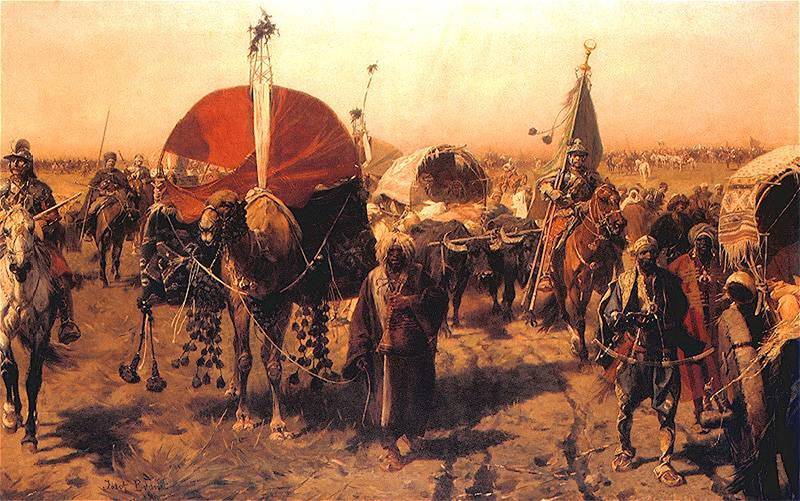
Europe, in spite of the emphasized, but for the most part still motivated, desire could in no way rally its forces to counteract Ottoman aggression. Having arisen in the depths of Asia Minor, the new center of power soon began to grow, its power and, accordingly, the possibilities steadily increased. Soon the young and, moreover, rapidly growing state became crowded in the regions where it originated - the Turks crossed the Bosphorus and the Dardanelles. Dilapidated and turned into a small enclave by the middle of the 15th century, the Byzantine Empire was mercilessly crushed by an Ottoman military machine. Before the newcomers from Asia stretched Europe, traditionally torn by internal contradictions, which will soon be added and religious. Most of all, the new threat that Constantinople had bitten by the megalopolis of that period, of particular concern, had, of course, been disturbed by its closest neighbors: Hungary and those who had considerable commercial interest wherever they could reach, Venice and Genoa. And only then, when it became absolutely clear that the Turks would not be content only with the Balkans, the need to make some decisions that went beyond the usual shaking of the air came before other monarchs.
At the beginning of the 16th century, when the Turkish scimitar began to sink deeper and deeper into the body of Europe, the Hapsburgs were already gaining power there. As a result, successfully concluded dynastic unions on the united throne of Austria and Spain sat down Charles V. While the Turks were gathering strength for a new cast to the north, in France, French king Francis I fought for control of this area with the Spaniards and Austrians - this rivalry ended in the battle of Pavia and the capture of the French monarch. In its striving to oppose the Habsburgs, by all means, France began to seek an alliance with the Ottoman Empire. And this treaty, signed by Suleiman the Magnificent and later ratified by Francis I, existed, in one way or another, until the Napoleonic invasion of Egypt.
The beginning of the reign of Suleiman the Magnificent was greeted with some enthusiasm - the sultan was known as an educated ruler. The fact that his father, Selim the Terrible, became caliph, the actual ruler of the entire Muslim world, and, of course, this title passed to his son, escaped the attention of observers of the then East. At the disposal of Istanbul were now the resources of the entire Islamic world: from the Moroccan deserts in the west to the Persian Gulf in the east. Despite all his education and refinement, Suleiman loved and knew how to fight. In Europe, he dealt a crushing blow to Hungary, defeating the army of Hungarian King Lajos II in 1526 during the reign of Mojac.
The conflict with Persia distracted the Turkish ruler from expansion to the west, but not for long. The seizure and plunder of Buda and Mohach protected the Balkan possessions of the Turks from the Hungarian threat - now it was necessary to take the next step and go further: take Vienna in order to strengthen itself purposefully in Hungary. In the spring of 1529, Mr. Suleiman left Istanbul at the head of a huge army. The expectation was that, faithful to the Allied duty, the newly released from captivity, Francis would again invade Italy, holding down the forces of Charles V, while the Turkish army would conquer Vienna victoriously, as it had taken Constantinople in 76 years before.
The emperor's brother, Archduke Austrian Ferdinand, had to rely only on his own strength. The city was not ready for defense, and measures to strengthen it were carried out in an incredible rush. Happily besieged, the city’s defense was headed by the 70, an old German mercenary Earl Nikolaus zu Zalm-Raifershaydt, a veteran of many wars, a participant in the Battle of Pavia, who personally wounded King Francis in the arm and himself wounded by the French monarch. The experience and talent of the old warrior in combination with an unusually rainy summer in Europe made significant adjustments to the military plans of Suleiman the Magnificent. Numerous Turkish siege weapons were left far behind in the rear because of the thick mud - the Turks had to rely on the construction of the tunnels. However, successes in a mine war turned out to be noticeably less than expected - warned of a defector about enemy underground works, the garrison of Vienna was on the alert. Several successful explosions were neutralized by the erection at the site of the breaks in the stock and debris.
Unsuccessful attacks, continued rains and the beginning of a shortage of provisions in the huge army of the Sultan caused grumbling in its ranks. Moreover, even elite parts of the Janissaries expressed discontent. After the failure of the general assault on 14 in October of 1529, when the military enthusiasm of the Turks stimulated not only a very significant monetary reward, but also a whip, Suleiman the Magnificent ended the siege and went to the winter apartments. The expansion of the Turks in Europe reached a milestone through which she could not step over. But in the abandoned huge Turkish camp, the winners found unusual brown beans. After some experiments, they were able to cook a pothead acceptable for consumption. So took one of the first Europeans dating with coffee.
Second attempt
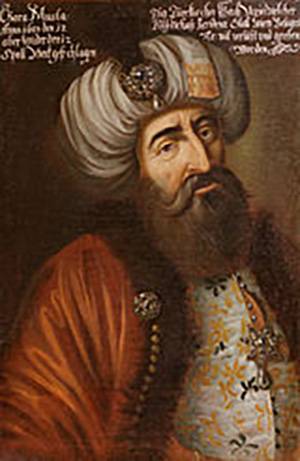
The next time the army of the Ottoman Empire appeared under the walls of Vienna more than a century and a half later. A lot of events have happened since that time in the Most Brilliant Port and in Europe. History It no longer presented the Turks with such a great ruler as Suleiman the Magnificent was - the quantity and quality of accomplishments of his less talented descendants and successors steadily declined, the country was shaken by the insurrections of local rulers and undermined swindling and intrigues of the sultan's environment. By the second half of the 17th century, the Ottoman Empire was already at the end of its military might and the swiftness of its foreign policy, but it was still quite strong and extensive. During this period of history, the name Köprülü meant a lot to Turkey. When Mehmed Pasha was appointed to the post of Grand Vizier in 1656, the city served as the beginning of the rise of the whole dynasty: right up to the beginning of the XVIII century. the post of Grand Vizier was held either by members of the Köprülü family, or their protégés.
Kara-Mustafa, who served as the Grand Vizier on the eve of the march to Vienna, was such a promoted person. Little is known about his childhood years. As a child, Kara-Mustafa was adopted by the Grand Vizier Köprülü Mehmed Pasha, who contributed to his adopted son’s career in various government positions. In 70's XVII century, he participated in several military campaigns, but was not noted as a skilled commander. His stepbrother was Köprülü Fazyl Ahmed, who in 1661 and appointed Kara-Mustafa as his deputy. In 1676, Kara-Mustafa himself was already becoming Grand Vizier - he proved himself to be a successful administrator in the administration of the empire, which allowed Sultan Mehmed IV to fully rely on him.
The power of the great vizier was impressive, and his dependence on the sultan was becoming more and more conditional. In order to finally strengthen his greatness and, perhaps, to claim for himself some new privileges, Kara-Mustafa hoped to achieve success now also in the military field. The most suitable combination, promising a hard-to-calculate political dividend, was the capture of Vienna - an achievement that was beyond the reach of Suleiman the Magnificent himself. The political situation, at first glance, seemed to have contributed to the military operation — the situation in imperial Hungary (part of this country was under Turkish rule at that time, and the other belonged to the Holy Roman Empire) was tense.
The reason for this was the religious enmity between Catholics and Protestants. The counter-reformation was especially harsh during the reign of the then emperor Leopold I. The struggle of the Catholic Church against Hungarian Calvinism and the attitude towards Hungary itself, as a conquered province, caused an increase in discontent among the Hungarian nobility. The leader of the Protestant party, a nobleman, a Calvinist, Imre Tököli, entered into open confrontation with the Hapsburgs. The Protestants were impressed by the religious tolerance of the Turks, and Tököli sent his envoys to Istanbul to agree on the coordination of actions against Leopold I in exchange for vassalit and recognition by his formal king of Hungary. The parties quickly came to a mutually beneficial agreement. In 1682, a fourteen-point agreement was signed with Tököli, in which he was officially recognized as a vassal of the Ottoman Empire.
For the grand vizier, the honorable Hungarian leader was an instrument for the realization of his own ideas, and therefore, when ambassadors arrived from the Holy Roman emperor to extend the Vashvarsky peace treaty concluded in 1664, whose term expired in 1684, they were politely and floridly rejected . This initiative was warmly approved by the French envoy to the Ottoman court, since Louis XIV had his own ideas on the Hapsburg part. Sultan, perhaps, did not want to “play for a raise” so swiftly and clearly, but omnipotent Kara-Mustafa could convince him that the process was under complete control and that was, in general, already in a turban. The ardent conviction of the vizier of the grand vizier was also imparted by the ardent confidence of the commander of the janissary corps, Tekirdadzhli Bekri Mustafa Pasha, who described his people’s readiness to fight in bright colors.
Mehmed IV still hesitated, because there was no formal reason to start the war against the Habsburgs. But the war was needed by the great vizier. In order to speed up the process, he spreads rumors about the growing tensions on the Hungarian border, and the Habsburg envoy, who is ready to accept very many conditions for the sake of peace, concludes under house arrest just in case. The conflict has matured. The large Ottoman army, which began to concentrate in the autumn of 1682 and overwintered in Adrianople (Edirne), was ready to go in the spring. 30 March 1683 The Turks marched north.
On North
By 3 in May 1683, the Turkish army, along with Sultan Mehmed IV, reached Belgrade. Her movement, like the army of Suleiman, was accompanied by rains, although not as intense. Nevertheless, technical and organizational difficulties arose - a lot of trouble was brought by the crossing of the beloved wife of Sultan Rabia Gulnush Emetullah, along with 80 carriages, in which the harem traveled, over the bridge over the river near Plovdiv. Meanwhile, Thököli’s forces joined the Danube with the expeditionary army of another Turkish vassal, the Crimean Khan, and arrived at the Ottoman army’s main apartment. After a little thought, the Sultan did not want to follow any further and already officially handed over command of all the combined forces to the Grand Vizier. At the military council that took place soon, it was announced that the initial task of the Sultan's troops was to capture the powerful enemy fortress of Gyor and after that the siege and assault of Vienna.
The Habsburg Empire was by no means in the best shape. Leopold I himself at first behaved completely unresolutely, completely disbelieving in the possibility of a Turkish invasion - the first part of the winter of 1682 – 1683. was spent on thinking about their own capabilities, counting these capabilities and neutralizing a panic attack after reviewing the results. The army of the Habsburgs was in a deplorable state: in the whole empire there were only 17 thousand cavalry and a little more than 40 thousand infantry, part of a very mediocre quality. The most moderate and balanced conclusion of the imperial generals about the necessary size of the army was the 80 of thousands of infantry and more than 20 of thousands of cavalry that could not be reached. An even more sad picture captures the state of the imperial treasury and the defenses of the fortresses. Cash content was not enough even to provide gunpowder in the right quantities.
And yet, the remaining time was spent on various diplomatic arrangements, primarily with the Polish king Jan III Sobieski, who had their own accounts with the Turks - in the recent war with the Ottoman Empire, the Poles were forced to cede it to Podolia. Traditional military support was also provided by large German state formations that were part of the Holy Roman Empire: Bavaria, Saxony, Swabia, and others. There was also no consensus regarding the action plan to repel the Turkish invasion. A more cautious game of Margrave Hermann Baden-Badensky suggested limiting himself to the stubborn defense of Gyor, covering the road to Vienna, and then, depending on the circumstances. Another imperial commander, the Duke Karl of Lorraine, advocated the occupation of the Hungarian fortresses Esztergom and Neuheusel belonging to the Turks before the arrival of the main forces of the Turkish army - these actions were supposed to strengthen the reputation of the imperial troops and force the Turks to retreat. In addition, such an action could have prompted the Polish king Jan Sobieski to actively support the Habsburgs. At the military council of 9 in May, Leopold I approved the defensive plan of Hermann Baden-Badensky, but spoke favorably about the initiative of Karl of Lorraine. The Duke was allowed to occupy the fortress of Esztergom and Neuheusel.
In early June 1683, the Turkish army reached Osijek, after which it continued moving north. The high pace of the enemy’s movement forced Karl of Lorraine to change his plans: he decided not to attack Esztergom, but to seize the less important and therefore weaker fortified fortress of Neuheusel, which was closer. Initially, her siege was very successful for the Imperials, but 8 June Leopold I ordered the end of the siege. Learning from the scouts that Kara-Mustafa was approaching Gyor, Karl of Lorraine advanced with his compact army (12,5 thousand infantry and 9,5 thousand cavalry). By the most conservative estimates, the Ottoman army numbered from 90 to 100 thousand people.
In an effort to prevent the Turks from penetrating deep into the empire, the duke took up positions at the fords across the river Rabu, having Gy Дr on his left flank. June 28 smoke numerous fires showed that the enemy is already close - in the vanguard of the Turkish army moved the Crimean Tatars, so that the traces of their activities could be observed already with the naked eye. The emperor showered the duke with various instructions, often contradictory. According to them, Karl of Lorraine was supposed to cover the fords, help protect Gyor and at the same time cover the road to Vienna.
However, now the campaign plan has been corrected by the Turks. In the camp near Gyёr, Kara-Mustafa gathered a military council, at which he suggested not to waste time and resources on the siege of the fortress, but to immediately speak to Vienna. Such a proposal did not dock with clear instructions from the Sultan, who, despite his all-embracing confidence in his Grand Vizier, nevertheless expressed a wish to master Gyёr. But Mehmed IV was at a great distance from the scene and could not in any way influence the decision of the Vizier. Turning the siege, the Ottoman army went straight to Vienna - in the current situation it seemed to be the right decision, given the confusion in the supreme command of the Holy Roman Empire, where intrigues, bureaucracy and projecting were comparable only to the atmosphere of the residence of the Pope of Rome. Seeing that the Turks had lost interest in Gyor, and in order not to be surrounded, Karl of Lorraine was forced to retreat. And in Vienna, where the news of the approach of the Turks was greeted with surprise, quickly replaced by shock, and, finally, horror, panic began quite predictably.
Under the walls
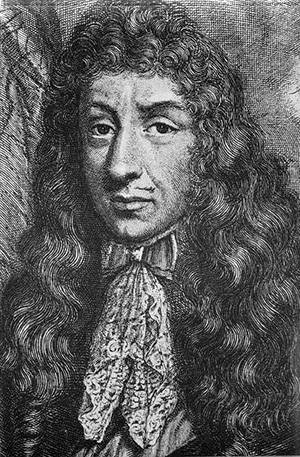
At first, the situation in Vienna was relatively calm. But in the spring, refugees began to flock there, telling about the frightening details of the inexorable movement of the Turkish army to the capital. The usual tensions of the front-line city began to grow and fueled by rumors, speculation and rich popular imagination. When it became known that the enemy was not stuck with Gyor, but was only in a few transitions, signs of excitement began to appear. The exodus began from the imperial capital: 7 July left Leopold I with his family and the treasury and state treasures stuck out on the way. The few empires who remained in Vienna, the head of the empire ordered to fight to the last opportunity - at that time there were no more than 2 thousand soldiers in the garrison. Following the head of state, the city was abandoned from 60 to 80 by the thousand inhabitants who followed the Linz in an unstoppable stream. Along the roads, Tatar patrols were already in full swing.
However, not all citizens chose the path of escape. In the city there remained a part of residents and refugees who, after wandering, well understood the price of strong stone walls. Vienna Mayor Johann von Liebenberg mobilized volunteers to erect fortifications and bring the city to a defensive condition. On July 8, a retreating army of Karl of Lorraine entered Vienna, reinforcing the garrison of the capital of 12 with thousands of soldiers commanded by the most experienced commander, Count Ernst von Starremberg. His appeal to render all possible assistance to the defense of the city was heard by almost everyone - with rare unanimity. July 12 Karl of Lorraine retreated from the city to the north across the Danube. He planned to connect with troops marching to Vienna. On the same day, Starhemberg, who is now the commander of the defense, ordered the destruction of the outskirts of the city in order to deprive the Turks of their hiding places. On July 13, the advance guard of the Turkish army was already in 15 km, in the village of Schwechat. Not doubting the success of the enterprise, Kara-Mustafa was right there. For the first time since 1529, soldiers of the Ottoman Porte have seen the walls of the capital of the Hapsburg Empire.
Siege
The Turkish army quickly took up positions around Vienna and began siege operations. Before guns entered the business, the grand vizier sent parliamentarians with a proposal for surrender and security guarantees in case of agreement. The traditional demand was followed by the same traditional refusal, and already on July 14 the Turks fired the first shelling of the city. Ottoman engineers and specialists in conducting a siege, examining the fortifications of Vienna, told Kara-Mustafa that the siege would not be easy - the enemy capital was well protected. Fortifications occupied space on the 100 m from the city walls and included gun bastions, a deep ditch and other engineering obstacles. It was decided to direct the main efforts towards deep undermining and undermining of the imperial fortifications, artillery was ordered to bombard the city, around which Turkish irregular and allied troops raged around them, robbing and ravaging everything that they came across.
Kara-Mustafa chose Neugebøyde Castle as its headquarters - the residence of Leopold I. It was believed that in this place in the distant 1529 there was the tent of Suleiman the Magnificent himself. A huge Turkish army is located in a semicircle near the besieged city, resting against the ends of a kind of crescent on the Danube. The construction of siege fortifications began, trenches were laid, which gradually led directly to the positions of the Austrians. The bombardment of the city gradually increased and 22 July 1683 became the most intense, which could indicate an early assault attempt.
On July 23, the first two mines were blown up by the Turks, however, the calculations were wrong, and the damage was minor. On Sunday, 25 July was blown up by an even more powerful charge, which was laid under the Löbel bastion, but failure lurked around the besiegers - only a small portion of the parapell fell. In the following days, the Turks continued their demining activities, activating more and more mines. On August 12, two very strong explosions were heard, paving the way for the enemy directly to the Palace Ravelin. The attack of the Turkish infantry was successfully repulsed with great efforts, but Ravelin himself lost the ability to be used as a firing position.
After the enemy army actually reached the walls of the city, slowly but surely grinding its fortifications, the garrison made several attacks. Initially, Stararember’s subordinates were lucky, and they managed to beat the Turkish wagons pretty well, but the next sortie ended up in a carefully prepared ambush and turned into big losses. After this incident, it was decided to focus on protecting the city. In early September, with massive attacks, the Turks finally managed to destroy the bastion of Löbel and Palace raelin strongly and penetrate into the defense of Vienna. Her garrison now consisted of no more than 4 – 5 Thousands of soldiers and militias, already exhausted, but determined to fight. The fate of prisoners in the wars with the Ottoman Empire was well known. Count Shtaremberg as an experienced military leader, who had fought under the banners of Raimondo Montecuccoli, the author of the famous Notes, was aware that without help, Vienna could not be restrained and her fall would become an accomplished fact in the coming weeks. However, in contrast to the defenders of another capital, Constantinople provided for their fate, who hoped only for a miracle and a Venetian fleet that did not come, the crowns had something to hope for.
Kings rush to the rescue
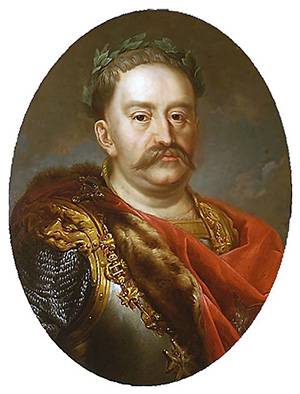
While the subjects of the Turkish Sultan were digging the pliable land of Austria, Duke Karl of Lorraine with a small army was not far from Vienna, trying to influence enemy communications with varying degrees of success. In the end, the Turks managed to pat the Duke’s commando army and force it to retreat deep into the territory. Karl understood that with his small forces - a little over 10 thousand people, mostly cavalry - would not be able to provide the capital with significant assistance. Therefore, at the end of July, he begins to send messengers intensively to Passau, to Bavaria, where Leopold I was now lodging, to the Polish King Jan Sobieski and to Johann George III, Elector of Saxony, with desperate requests to finally unlock the army and come to the aid of the besieged Vienna .
Together to resist the threat from the east was not easy in Europe. It was much more interesting and exciting to organize armed trials due to dynastic, economic or political differences, when the blades of debaters were uncovered, the ink barely dried out under another contract that no one was going to execute, or a disputed testament. To fight the Turks was troublesome, dangerous and expensive. The last time, when the Sacred League was created (and it was in the distant 1571), only the Pope of Rome’s energy, perseverance and diplomacy prevented the Christian army from killing each other before contact with the enemy. Now, in 1683, the situation was no better: the Ottomans were almost in the center of Europe, but few were eager to defend it. In this situation, the Hapsburg had to rely only on the help of the weakened Polish-Lithuanian Commonwealth, skillfully playing on the political ambitions of its king Jan Sobieski.
The territorial losses suffered (as a result of the peace treaties with the Turks 1672 and 1676) and the Polish state sought revenge, united in an uneasy alliance with the Hapsburgs in the spring of 1683. On August 15, Jan Sobieski launched from Krakow, and by the end of the month his army was already in the area of Holbrune, northeast of Vienna. Soon, it was joined by the forces of Karl of Lorraine, and a little later - military contingents from Saxony, Bavaria and Franconia.
The dense Vienna Woods, located in the rear of the Turkish positions, was considered by the Ottoman command an impassable obstacle, and a few numerical pickets were placed near it. Karl of Lorraine had a different opinion on this matter. On September 10, with the help of hunter-guides, the Christian army made a quick march through the forest, and in the morning of September 11, the forward detachment from the 60 musketeers, interrupting the Turkish picket, climbed the high ridge of Kalenberg, from which the besieged capital was visible. Kara-Mustafa has long been convinced that there is no place to wait for the help of the besieged. However, the captured 8 of September reported unpleasant news: the 80-thousandth army approaching the Turkish camp, having about 150 guns. The Grand Vizier did not want to hear about lifting the siege - his career, and life, was at stake. His first event against the threat that had arisen was the removal from 60 of guns and 6 thousand infantry and placing them against the expected enemy. Soon 22 – 23 thousand cavalry were added to them. Since the terrain between the Kalenberg ridge and the Turkish camp was abundant in ravines, dense shrubs and other natural obstacles, Kara-Mustafa decided that the measures he had taken were sufficient. Both armies settled down for the night in sight of each other.
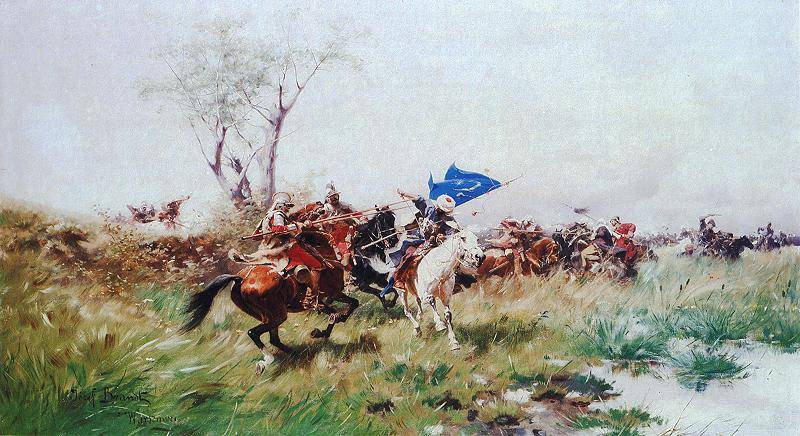
On the morning of September 12, 1683 of the Christian troops began to move. They descended in columns from the hill to the Turkish positions. Overall command was carried out by Jan III Sobieski. On the left flank were the imperial troops (18 thousand), in the center - the German contingents (32 thousand). The Poles (27 thousand), who were longer than others deployed and put themselves in order, were located on the elevations of the right flank. The battle immediately became fierce: the allies attacked in dense masses, widely using musket fire and bristling with peaks. Numerous field guns rolled along the plain manually, stopping them at firing lines. The Turks constantly counterattacked, but these efforts, made in haste and without any order, brought them only great losses.
A few delayed Poles appeared on the battlefield around noon, when the situation was already favorable to the Allies, but was not yet certain. Then Jan Sobieski led the best part of his army to attack - the elite heavy cavalry of the winged hussars. The Polish king personally led his warriors. The Turks had their own excellent heavy cavalry - sipahs, but they could not stop the onslaught of hussars who, on the shoulders of the running enemy infantry, broke into the Turkish camp. Kara-Mustafa, seeing that the situation was rapidly getting out of control, tried to organize a desperate counterattack - all his bodyguards and henchmen died, and the great Vizier was hardly persuaded to leave the battlefield. The Ottoman army rushed to flee, leaving their numerous property. At about 18 hours, taking away the treasury and personal banner, the Commander-in-Chief, the Grand Vizier, left his tent and joined the retreating army. The battle is over - the siege of Vienna was lifted. The Turks lost about 15 thousand killed and wounded, all artillery and most of the convoy. 5 thousand were captured. The Christian army lost 4 – 4,5 thousand dead and wounded.
Differences between the allies broke out the very next day. The main winner, Jan III Sobieski, dared to enter the city before his legitimate emperor, Leopold I, who had been watching the battle from far away. The Germans soon also quarreled, and some of them returned home. The Turkish army, pursued by Carl of Lorraine, retreated in disarray towards Belgrade. The Turkish commander executed several of his generals, blaming them for failure, but at the end of December 1683 himself was strangled by order of Mehmed IV, apparently not only because of a crushing defeat, but also out of fear of new strategic projects of the ambitious grandee. The war of the Ottoman Empire against the coalition of European powers continued until the 1699 year and ended with the signing of the Karlovitsky peace. On the threshold was the XVIII century, in which a weak and resilient Porto was faced by a strong and stubborn opponent, new troubles and defeats.
Information